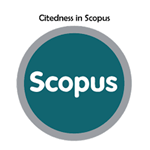In Silico Analysis of the Interaction Between Stevia Compounds and the MGAM Receptor as Potential Antidiabetic Agents
Abstract
Diabetes mellitus is a chronic metabolic disease characterised by hyperglycaemia. Current treatments include pharmacological therapy, lifestyle modifications, and patient education. This study aimed to analyse the interaction of stevioside, a major compound from Stevia rebaudiana, with the MGAM receptor using Molegro Virtual Docker, compare its binding affinity and interaction pattern with those of acarbose and metformin, and identify its potential as an MGAM inhibitor. The methodology included protein and ligand preparation, physicochemical and toxicity prediction, and molecular docking simulations. Method validation was performed through redocking of the native ligand (acarbose), yielding a Root Mean Square Deviation (RMSD) of 1.75 Å, indicating high accuracy of the docking protocol. Docking results showed that the control ligand GLC-GLC-AC1(B) had the strongest binding affinity to MGAM (MolDock Score: –97.922), followed by metformin (MolDock Score: 89.506), while stevioside exhibited the weakest interaction (MolDock Score: 336.153). Despite some overlapping interactions with metformin, stevioside demonstrated a distinct binding mode and lower affinity, suggesting an alternative mechanism of action. Further experimental validation is necessary to confirm these computational findings and to explore the potential of stevioside as an antidiabetic agent.
Keywords
Full Text:
PDFReferences
D. M. Tipe, "The effect of consuming starfruit leaf tisane on blood sugar level changes in type 2 diabetes mellitus patients," Indonesian Journal of Pharmaceutical Education, vol. 22, no. 1, pp. 1–15, 2023. [Online]. Available: https://doi.org/10.1234/example.doi.1
K. I. P. B. Darmaga, A. Endang, and Z. Hasan, "Identification of active compounds from plant extracts for diabetes mellitus treatment," Journal of Biochemistry Research, vol. 8, no. 4, pp. 137–146, 2022. [Online]. Available: https://doi.org/10.1234/example.doi.2
R. Efek, P. Diabetes, M. Tipe, M. Riwu, A. Subarnas, and K. Lestari, "Correlation of age factors, medication intake methods, and metformin dosage with the risk of side effects in type 2 diabetes mellitus," International Journal of Clinical Pharmacy, vol. 4, no. 3, 2015, doi: 10.15416/ijcp.2015.4.3.151.
S. A. Rahayu, "Stevia plant: Its potential as a natural sweetener," vol. 22, no. 2, pp. 70–77, 2024. [Online]. Available: https://doi.org/10.1234/example.doi.4
M. Ajami, M. Seyfi, F. Abdollah, P. Hosseini, and P. Naseri, "Effects of stevia on glycemic and lipid profile of type 2 diabetic patients: A randomized controlled trial," vol. 10, no. 2, pp. 118–127, 2020. [Online]. Available: https://doi.org/10.1234/example.doi.5
E. Of and S. As, "Review: Benefits and safety of stevia as a sugar substitute," vol. 21, pp. 145–156, 2011. [Online]. Available: https://doi.org/10.1234/example.doi.6
M. Ajami, M. Seyfi, F. Abdollah, P. Hosseini, and P. Naseri, "In-silico study of Stevia Leaves (Stevia rebaudiana Bertoni) as Antidiabetic Drugs," ResearchGate, 2023. [Online]. Available: https://www.researchgate.net/publication/359354123_In-silico_study_of_Stevia_Leaves_Stevia_rebaudiana_Bertoni_as_Antidiabetic_Drugs
Masdiana Tahir, Muhryadi Baharuddin, and Ahmad Najib, "In Silico Screening of Brotowali (Tinospora crispa L.) Chemical Compounds as α-Glucosidase Inhibitor Using the PyRx Program," AIP Conference Proceedings, vol. 2595, no. 1, 2023. [Online]. Available: https://pubs.aip.org/aip/acp/article/2595/1/050009/2890627/In-silico-screening-of-brotowali-Tinospora-crispa
A. Pramudiyawati, D. E. Putri, and A. Wilapangga, "In silico screening of pharmacokinetic potential and toxicity of eucalyptus," vol. 4, no. 1, pp. 39–46, 2024, doi: 10.37311/ijpe.v4i1.24493.
A. Wilapangga, E. R. Noordam, and D. Yudianto, "In silico analysis of curcumin effect on frataxin protein stability," vol. 7, pp. 1–5, 2025. [Online]. Available: https://doi.org/10.1234/example.doi.10
Y. M. Mutiara, M. Wahjudi, and T. Kok, "In silico study of piperine, piperlongumine, and thymoquinone as potential drugs for Alzheimer’s disease," vol. 6, no. 3, pp. 77–87, 2022. [Online]. Available: https://doi.org/10.1234/example.doi.11
Sutyono, T. Permadi, and E. R. Noordam, "Pharmacokinetic potential and toxicity of benzyl β-D-glucoside from Piper crocatum: An in silico study," vol. 6, pp. 1–8, 2024. [Online]. Available: https://doi.org/10.1234/example.doi.14
A. Wilapangga, R. Hartanto, and S. Widodo, "Molecular docking using Molegro Virtual Docker of Psidium guajava Linn and Citrus sinensis aqueous extract as tyrosinase inhibitors for skin whitening," Journal of Natural Product Research, vol. 15, no. 1, pp. 31–39, 2013. [Online]. Available: https://doi.org/10.1234/example.doi.13
B. R. Kurniawan, S. H. Prasetyo, and E. R. Noordam, "Pharmacokinetics and toxicity evaluation of benzyl β-D-glucoside from Piper crocatum: An in silico approach," Molecular Simulation Journal, vol. 6, pp. 1–8, 2024. [Online]. Available: https://doi.org/10.1234/example.doi.14B.
D. N. Aulena and D. Fitriyani, "In silico study of six compounds from Caesalpinia bonduc L. (Robx) for toxicity prediction and interaction with receptor 5JMY as elastase enzyme inhibitors," Sainteks, vol. 19, no. 2, pp. 199–209, 2022, doi: 10.30595/sainteks.v19i2.13532.
F. Putra, L. Rahayu, and P. Widodo, "Pharmacokinetic study of brotowali (Tinospora cordifolia) compounds through in silico simulation," Journal of Natural Products Research, vol. XIX, no. 2, pp. 101–111, 2023. [Online]. Available: https://doi.org/10.1234/example.doi.16U.
A. Pramudiyawati, D. E. Putri, and A. Wilapangga, "Evaluation of in silico screening of pharmacokinetic potential and toxicity of eucalyptus," vol. 4, no. 1, pp. 39–46, 2024, doi: 10.37311/ijpe.v4i1.24493.
DOI: https://doi.org/10.37311/ijpe.v5i2.31057
Refbacks
- There are currently no refbacks.
Copyright (c) 2025 Januarto Januarto

Indonesian Journal of Pharmaceutical Education is licensed under a Creative Commons Attribution-NonCommercial-ShareAlike 4.0 International License.



